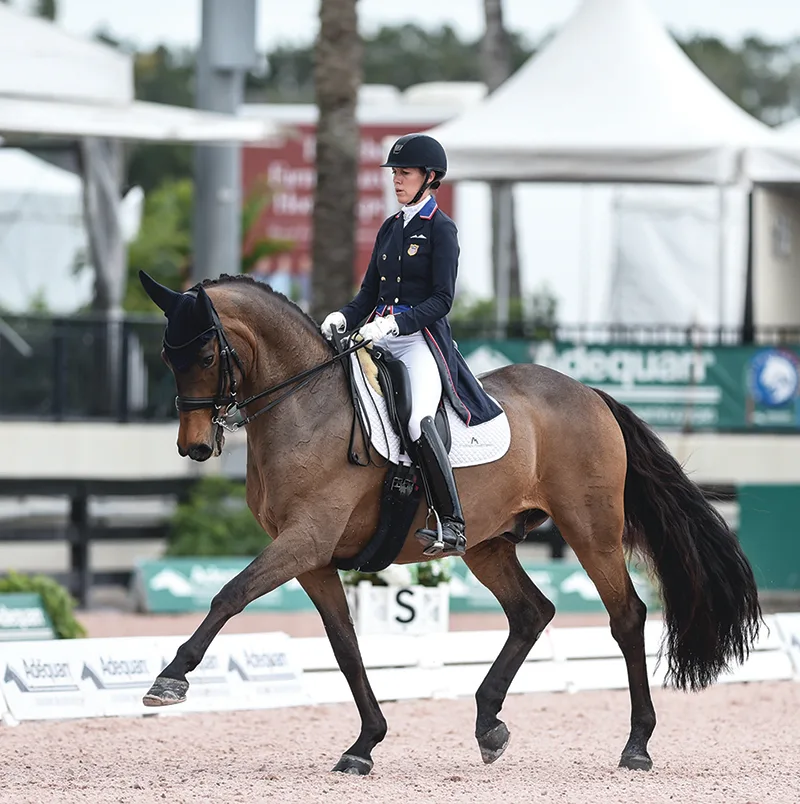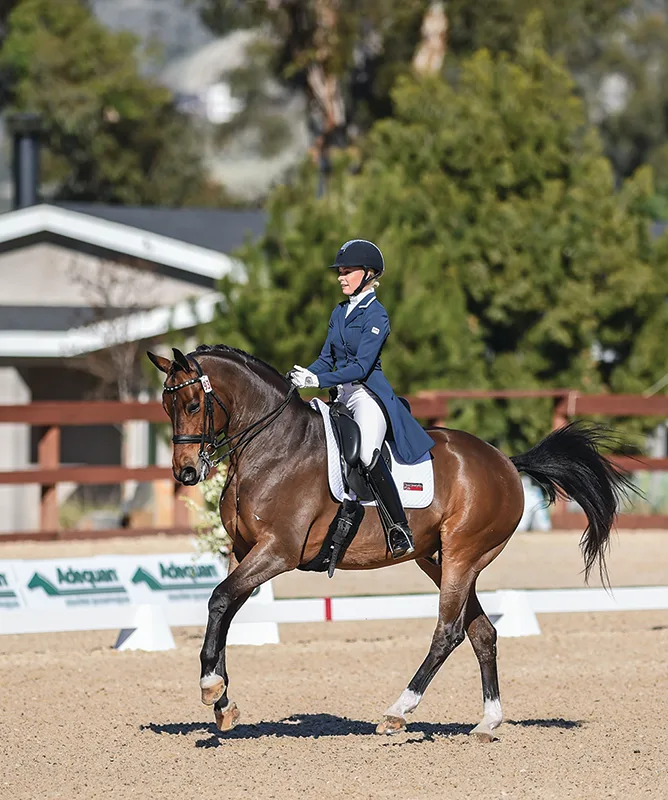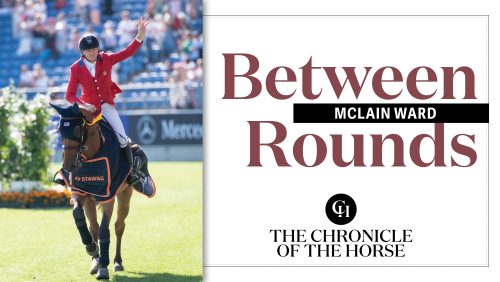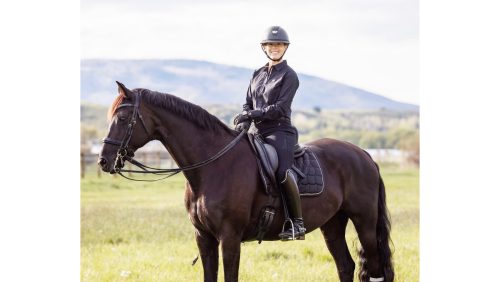Ah, the perfect sitting trot, when horse and rider move as one, and there’s nary a bounce in sight. Though it seems like it would be simple, all riders know there’s much more to it than just, well, sitting there. It takes special skills, fitness and a willing equine partner to make it work.
We asked three dressage trainers for their tips.
Olivia LaGoy-Weltz
Sitting the trot without stirrups really helps. It’s not just a torturous thing; it makes people more inclined to let gravity help them, and it takes out your dynamic with your foot in the stirrup. It really just lets you connect there.
When you take your stirrup back again, the rider and trainer have to notice: What is that person doing with the foot in the stirrup that may be causing it to be difficult to sit the trot? Are they actually bracing in the stirrup or standing in the stirrup, or clamping and pointing their toe down and over-flexing their calf? If the person sits the trot better without the stirrup then you have to look at how all the joints are functioning once the stirrup is taken back.
Another exercise would be doing trot-walk, walk-trot transitions. You’re already sitting in the saddle and can move up to trot and try to stay with the saddle.
The other piece is finding the sweet spot for every rider and horse of core tone. You have to have a good amount of core tone to sit the trot. Too much would make you a little jackhammery. Too little can make it floppy.
You’re looking for a dynamic core tone. Some people naturally [have] a higher muscle tone; some are naturally lower muscle tone. In some ways low core-tone people can appear to sit the trot really well, but then they’ll be too floppy. Higher core-toned people can have a hard time because it’s hard to relax down and around. Be aware of how engaged your core is in this process. If we took your leg away, could you stay sitting up?
In terms of talking about it, the trot, if you were going to graph it, is shaped like an M. The horse goes up and through the air and across the ground and down onto the ground, and then up and through the air and across the ground and then down onto the ground. For the rider, also really thinking that your seat makes these M shapes—you’re kind of gently pogo-sticking around. Letting the horse lift you in the up is really important. You start sitting the trot from the down, so you’re sitting in the down, and the horse lifts you up, then you’re ready to go back down with it again. So that down is the home base, so to speak.
ADVERTISEMENT
Olivia LaGoy-Weltz, Haymarket, Virginia, and Wellington, Florida, served as team alternate at the 2015 Toronto Pan American Games and 2018 FEI Tryon World Equestrian Games (North Carolina).
Shelly Francis
I have a lot of amateurs, and I help them in a way to help the horses too, so they’re not bouncing around too much.
I always have them do rising trot a little, and then sit three, four, five strides, then post four or five strides again, and so on. I have them repeat that over and over, and I tell them they should do that all the time. It helps them learn to sit and get more comfortable with the horse.
I want to help the riders feel comfortable. You can do some shoulder-in and do a little rising trot, a little sitting when it feels like the horse is comfortable. I always have them sit when the horse feels steady and quiet in the hand and nicer over the back. Then they can learn to sit that because it’s not so uncomfortable, and as soon as they start bouncing I’ll say, “OK, now do some rising trot.” Ideally you want to start posting before they start bouncing, so the horse stays through.
When I’m training people it’s about the training of the horse as well as the rider. I want them to have a good position; then it kind of comes together when they get more comfortable with getting their horse more through, so most of those riders learn to sit better then. I let them be in rising trot and get the horse softer over the back and neck and more laterally flexible and steady and then say, “OK, now we’re nice and steady, so sit some strides, and if it feels like you’re going to bounce, rise a little bit and get organized and get the horse soft again and sit again.” If they practice it that way a little bit every day then in a few weeks they’re sitting the trot better.
You can do yoga and Pilates and be fitter and more flexible, and that all helps. But when I’m just taking the rider as they come to me on their horse, I try to help the horse and the rider instead of the rider and the horse. Then everybody’s happier: The horse is happier; I’m happier; the rider becomes happier, and they learn to get more comfortable. Then they don’t feel so pressured that they have to sit that trot no matter what.
[Allowing riders to post sometimes] is a little more practical and lenient for the rider, so the amateur doesn’t have that pressure and feel so bad that they can’t do it. I think you should give yourself a chance—just do a little at a time. I want the riders to think, “Yeah, I can do this.”
A veteran of the 1998 FEI World Equestrian Games in Rome and the 2018 FEI World Cup Final in Paris, Shelly Francis was also named the traveling reserve for the U.S. dressage team at the 2016 Rio de Janeiro Olympic Games. Francis, who’s based in Ocala, Florida, won the 2018 Grand Prix freestyle at the Aachen CDI4* (Germany) with Patricia Stempel’s Danilo.
ADVERTISEMENT
Niki Clarke
The best way to learn to sit the trot is a good old-fashioned longe-line lesson with no stirrups and no reins, as long as the student has a horse that they’re able to do that on. This gives riders a chance to figure out their balance and what it means to use their core to help them sit the trot and to hold their balance, and not squeeze with their legs to hold themselves on. That’s the biggest thing I find: People are sitting the trot, but they’re doing it by hanging on with their legs. So you’re not really sitting the trot at that point, and you’re sort of held captive because you’ve reduced what you’re able to do with your legs because you’re using a large portion of it just to stay in the saddle.
There’s nothing that can replace a longe lesson. People want to avoid sitting the trot, or they don’t like to do it because it’s hard, and it’s a struggle. Especially with horses, you’re really not going to improve without the struggle. You have to get out of that comfort zone; that’s my biggest piece of advice. I have a saying, “If you’re feeling uncomfortable, you’re probably starting to do it right.” Same thing with learning how to sit the trot. You have to be able to get to that place where you’re uncomfortable and then fight through that and try to relax and move with the motion and not clamp yourself in there. Longe-line lessons are the best way to help with that.
I’m also a big physio person. [Physios] Britta Pedersen, Andy Thomas, Stephanie Seheult are amazing, and they’ve helped me so much with my own riding. There are a lot of difficult components; for instance, if a rider’s core isn’t what they call turned on, if it’s not firing, it makes everything harder. There are a few little adjustments they can help with to really help your clients figure out and become more knowledgeable about why they’re struggling, or what part of their body they need to gain control over to help themselves in a better way.
The physios show you exercises. It’s not working out; it’s little exercises to isolate the smaller groups that usually get turned off by your larger muscle groups to kind of wake those muscles back up, and you feel different parts of your body being able to fire. For instance, somebody who has overuse of their hip flexors—I’m one of those people—tends to shut down their lower abs. Sometimes you want to use your core, and you want your abs to be engaged, but you can’t get them to because your hip flexors are overruling them.
At the end of the day what nobody wants to hear is that you just have to keep doing it. There are not a lot of magic potions; it’s just time in the saddle. When I was growing up, I had an amazing event horse, but he was bred for dressage. He had a really bouncy trot, and I learned how to sit the trot from having him growing up. Learning to sit the trot is really hard and really important.
Niki Clarke, a U.S. Dressage Federation gold, silver and bronze medalist, runs Dressage Unlimited in Temecula, California. In 2018 and 2019, Clarke was named to the USEF Dressage Development Program with Coral Reef Ranch’s Coral Reef Scoobidooh.
This article appeared in the May 18 & 25, 2020, issue of The Chronicle of the Horse. You can subscribe and get online access to a digital version and then enjoy a year of The Chronicle of the Horse and our lifestyle publication, Untacked. If you’re just following COTH online, you’re missing so much great unique content. Each print issue of the Chronicle is full of in-depth competition news, fascinating features, probing looks at issues within the sports of hunter/jumper, eventing and dressage, and stunning photography.
What are you missing if you don’t subscribe?

















